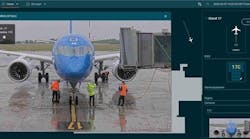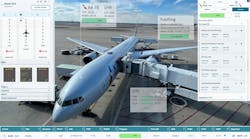Wearable technology is making a big impact on the ground support industry. The International Air Transport Association (IATA) says that from discreet notifications, which allow workers to have maintained concentration, to augmented reality, which provides real-time instruction on processes, procedures, warnings and more, there are many products available that can save time and improve safety.
In the cargo industry alone, the organization says international trade is set to double in the next 20 years, with many facilities becoming automated by 2030.
Joe Surprenant, Director of Sales for North America and APAC at Vuzix, says with that predicted growth, the area of opportunity for smart technology in ground support is vast.
“You have a lot of moving parts and today the only way to really gain information on what that part is, and where it belongs is by looking at a static clipboard, calling back to an expert or sometimes making a well-educated guess,” he explains.
This causes challenges around the ideal movement of large containers, but also causes safety issues because the cargo must be placed in a very specific location on a plane to account for balancing and various regulations before it is allowed to fly.
SATS, based in Singapore, has adopted various options of wearable technology in volume. Through funding by the Civil Aviation Authority of Singapore and Singapore Economic Development Board, SGD110 million has been committed for technological innovations.
The company uses a people-led approach to technology and concurs that wearable technology has increased productivity as well as enhanced accuracy and safety. Representatives say the deployment of technology has enabled the company to scale its operations efficiently, improve services and ensure sustainability of the business.
The Reality with Augmented Reality
For SATS, the capability of smart glasses replaces the paper-based reports typically used for ramp handling operations. Representatives say the technology allows staff to execute baggage and cargo loading more efficiently and with better accuracy.
They add that the load control specifications for each aircraft (traditionally printed on rolls of paper) are reflected on the smart glasses with the augmented reality (AR) technology. The smart glasses also offer a “see-what-I-see” function that enables the ramp control center to observe the on-ground operations in real time.
AR technology has digitized SATS’ ramp operations, enabled shorter turnaround times and enhanced the precision of the loading process. IATA representatives agree, noting that in areas where the workforce is physically spread out, minutes are saved in each task when a ground support operator does not have to use the radio or return to the warehouse for assistance.
At SATS, technology has enabled them to operate more efficiently, but also ensure the sustainability of the overall business.
“Viewed over a longer time frame, the investment we put into new technology today will enable SATS to keep pace with changes in the aviation industry and stay competitive,” company officials explain.
SATS is also the first in the world to leverage the Internet of Things (IoT) through a smart watch for its technical ramp operations. This allows them to streamline the on-ground processes and enhance communications, productivity and again, safety. The watch tracks and monitors performance, too, by digitally capturing the start and completion time of each task. Additionally, it has helped with resource planning for a variety of ground handling processes.
“We are constantly reviewing our business processes and investing in technology to improve productivity,” SATS officials add. “Our customers welcome technology and innovative initiatives and developments that can help create value for them. The use of augmented reality has shaved 15 minutes off the time it takes to turnaround an aircraft and eliminates errors in loading cargo or baggage.”
The Next Generation
“While not specific to the ramp, augmented reality can certainly play a role in the coming years,” IATA representatives explain. “For example, instructions, restraints and securing of loads could be assisted through this technology. Apply artificial intelligence to the data, and these instructions can be more than just reminders of procedures, but suggest the securing approach with instructions, tests and approved tolerances pinpointed on the image.”
In another thought, the organization says wearables can also benefit workers for health and safety aspects, to identify medical emergencies, call for help, etc.
The industry is bubbling in demand for these technologies and are looking at the early adopters like SATS to see how it truly performs in the field.
“Then, it’s game on,” Vuzix’s Surprenant says. “Industry leaders realize the value of hands-free solutions and what it provides. It’s just a matter now of how to deploy thousands of units to some organizations. How do you charge 400 devices? Where do you store them? How do you train people? These are the things that Vuzix provides thought leadership to leverage these solutions at scale.”
He says as rollouts continue to occur, the Vuzix team is leveraging the expertise of other companies to enable local support where available and wants to see ground support providers feel comfortable to ask any questions they may have about wearable technology. Surprenant acknowledges that while user adoption may appear to be a challenge, wearable technology has grown to be comfortable to wear all day and it offers a serious competitive advantage.
Providing information to an operator in a heads up and hands-free way is what the company calls the “Holy Grail” of the wearable technology, and it’s been found through these innovative products.
Wearable technology will continue to grow as more ground support providers see the value in their numbers.




